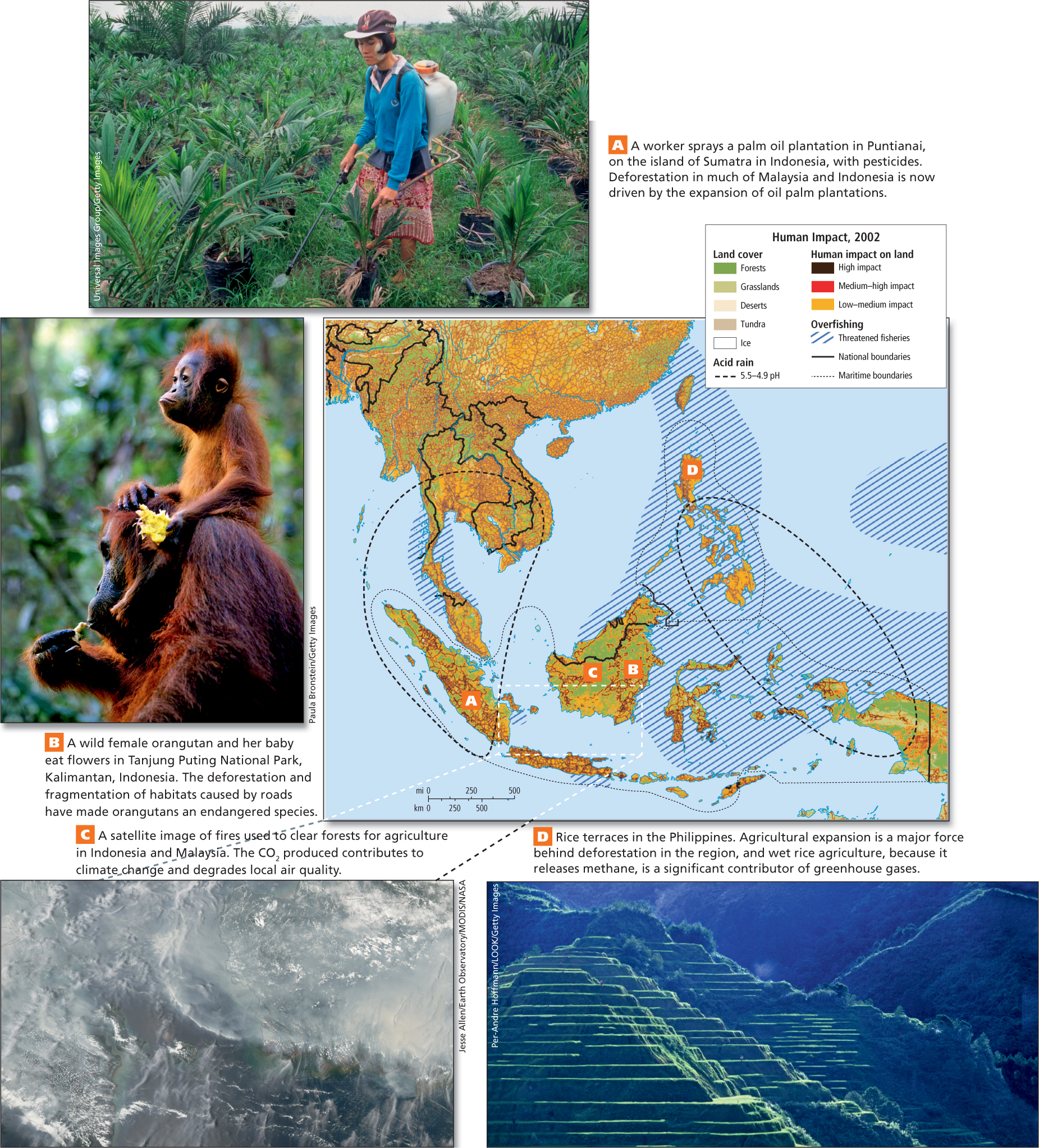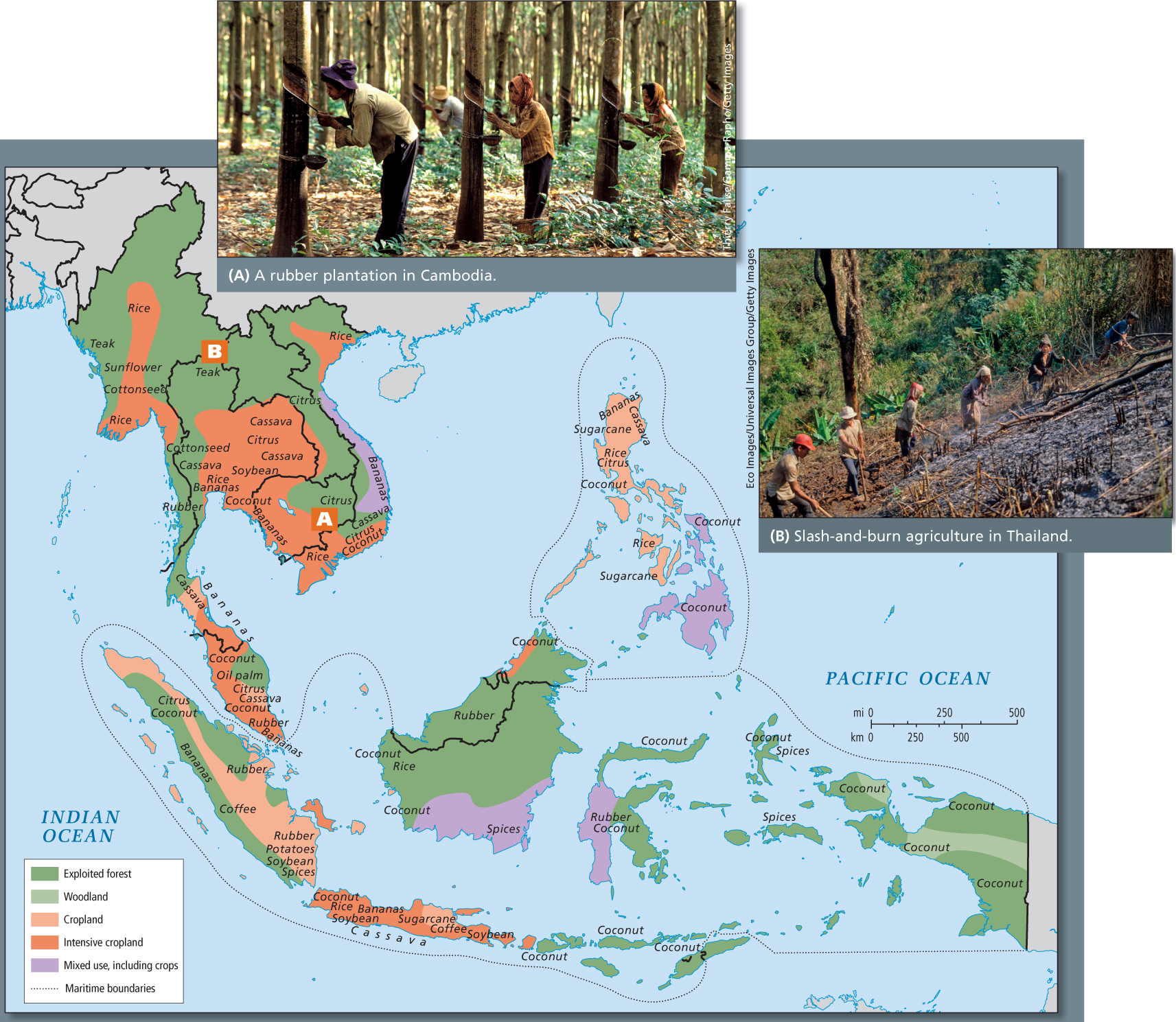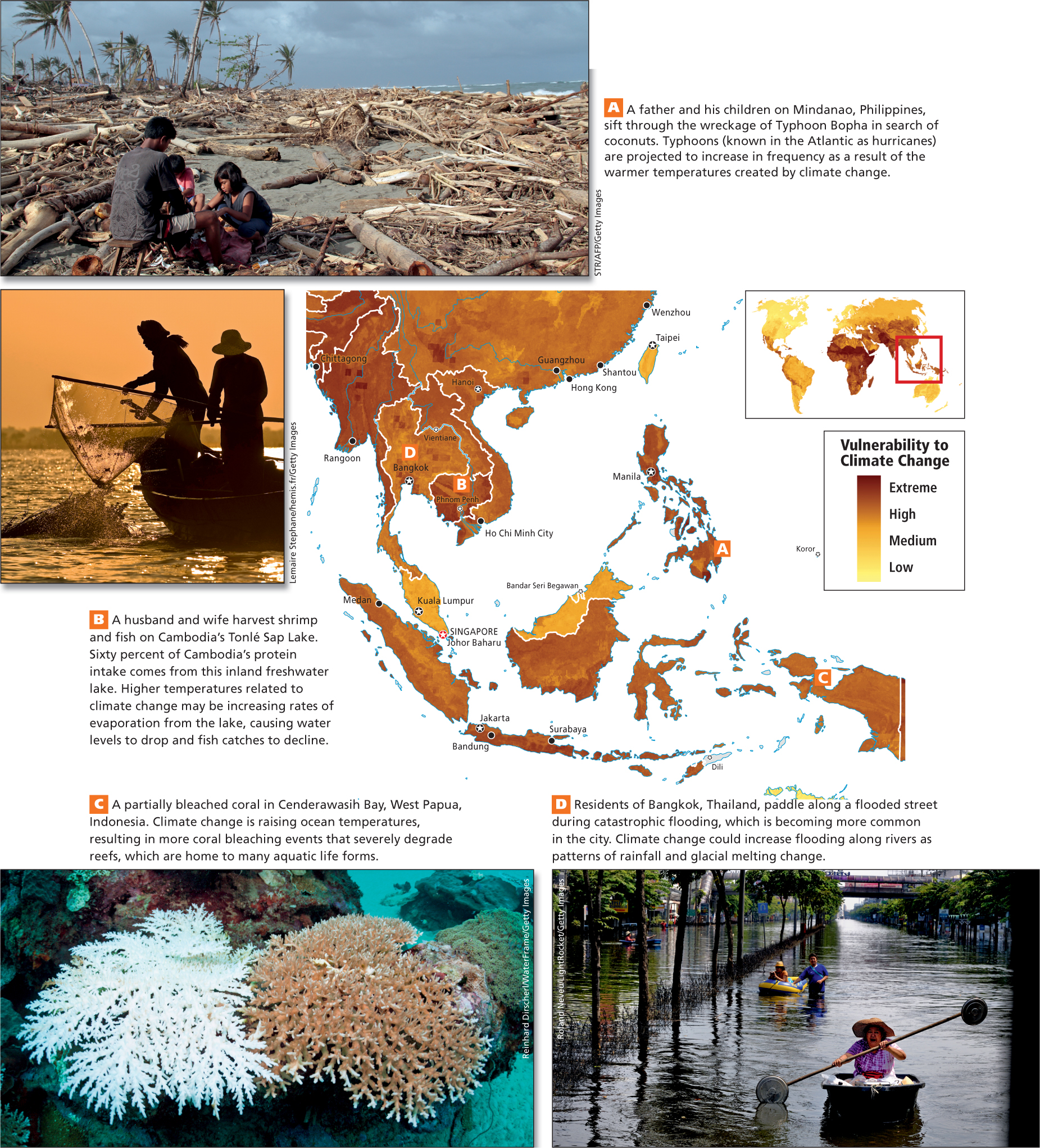10.3 ENVIRONMENTAL ISSUES
GEOGRAPHIC INSIGHT 1
Environment: Many of Southeast Asia’s most critical environmental issues relate in some way to climate change. Deforestation is rapid in this region and is a major global source of greenhouse gas emissions, which intensify climate change. This region is also highly vulnerable to the impacts of climate change. Increased flooding and droughts threaten food production on land and rising ocean temperatures strain aquatic ecosystems.
Deforestation
Southeast Asia has the second-

THINKING GEOGRAPHICALLY
Question 10.1
What happens to the atmosphere when there are fewer trees due to legal or illegal logging?
The regional environmental impacts of deforestation and the agriculture that often follows it are addressed in Figure 10.9. One effect is that indigenous people of the forest lose their living space and resources when the land is given over to export agriculture. Another is the loss of habitat for orangutans, the Sumatran tiger, the Sumatran rhinoceros, and tens of thousands of other less well- 222. INDONESIA’S POLLUTED ENVIRONMENT THREATENS HAWKSBILL TURTLE
222. INDONESIA’S POLLUTED ENVIRONMENT THREATENS HAWKSBILL TURTLE

THINKING GEOGRAPHICALLY
Use the Photo Essay above to answer these questions.
Question 10.2
A How does this landscape of recently planted oil palms differ from that of the forest that was removed for this plantation?
Question 10.3
B What are these orangutans eating? Do you think these animals would relish a meal of oil palm leaves? Why is this likely or unlikely?
Question 10.4
C Can you identify the geographic locations barely visible through the smoke?
Climate Change and Deforestation
Deforestation is a major contributor to global climate change because enormous amounts of carbon dioxide (CO2) are released when forests are removed and the underbrush is burned. Fewer trees also mean that less CO2 is absorbed from the atmosphere. Every day, 13 to 19 square miles (34 to 50 square kilometers) of Southeast Asia’s rain forests are destroyed, much of it done illegally. A great deal of this deforestation takes place in Malaysia and Indonesia, where the logging of tropical hardwoods for sale on the global market is a major activity (see Figure 10.8).
Significant amounts of CO2 are also released when the forests are converted to oil palm plantations, especially when the forest is burned to clear the land for the plantations. For decades, these activities have made Indonesia among the world’s biggest contributors to global climate change. Since 1950, the tropical forest cover on the Indonesian part of the island of Borneo alone has decreased by about 60 percent. Oil palm plantations now constitute the predominant use of land there.
The Costs of Logging, Legal and Illegal Deforestation costs Southeast Asian countries billions of dollars per year in lost forest services, such as renewable food, construction material, and fuel resources; rainwater capture and purification; flood amelioration; biodiversity preservation; and CO2 absorption. Government regulations that limit logging have been constrained by rampant corruption, but recent efforts to enforce limits may be yielding results. With a vision of sustainable logging as a long-
Oil Palm Plantations Palm oil, which is used around the world in food products, as a cooking oil, in soaps and cosmetics, and as a machine oil, is at the center of debates over global climate change in Southeast Asia. The oil palm originated in West Africa and was brought to Southeast Asia early in the colonial era. Today, Indonesia and Malaysia are the world’s largest palm oil producers, and the expansion of their oil palm plantations has resulted in extensive deforestation. Much of the deforestation is in lowland peat swamps which, in a natural state, are capable of storing large amounts of carbon in their soils. To create space for oil palm plantations, the swamps are drained and most of their vegetation is burned (see Figure 10.9A). Often the fires spread underground to the peat beneath the forests, smoldering for years after the surface fires have been extinguished. These subsurface fires release enormous amounts of carbon into the atmosphere. In recent years, smoke from burning forests and peat has periodically covered much of the region, dramatically reducing air quality and even making it necessary for people in rural areas to wear masks.
Palm oil has been promoted as a potential solution to global climate change because it can be converted into fuel for automobiles. The claim is that because the palm trees absorb CO2 from the atmosphere just as the original forest did, palm oil could be considered a “carbon neutral” fuel. This is a fallacy because palm trees do not absorb carbon at a rate equivalent to natural rain forests—
Climate Change and Food Production
Food production contributes to global climate change in two ways. First, it is a major contributor to deforestation, and second, some types of cultivation actually produce significant green-
ON THE BRIGHT SIDE
Indonesia Tries to Slow Deforestation and Reduce Greenhouse Gas Emissions
In 2011, as part of Indonesia’s ongoing efforts to reduce greenhouse gas emissions, President Yudhoyono of Indonesia announced a 2-
The moratorium was renewed for another 2 years in 2013 to enable the government, corporations, and foresters to adjust to a long list of changes aimed at reducing pressure on existing old-
Shifting Cultivation Also known as slash-

THINKING GEOGRAPHICALLY
Question 10.5
On plantations of all types, native plants are replaced by marketable crop plants. What might be a way in which using slash-
Where population densities are relatively low, subsistence farmers can practice sustainable shifting cultivation indefinitely, but to allow for long fallow periods and still support human populations, this system requires larger areas than other types of agriculture. If population density increases, farmers are usually forced to shorten fallow periods, thus inhibiting forest regrowth and soil regeneration. Even though individual plots are small, the plots eventually become close to one other because shifting cultivation requires clearing forest at each move. Shifting cultivation now accounts for a significant portion of the region’s deforestation. Moreover, because burning usually clears the forests, shifting cultivation can result in wildfires. This is especially true during an El Niño period, when rainfall is low. These wildfires have increased in recent years, particularly in Indonesia, further contributing to deforestation and carbon emissions there.
Wet Rice Cultivation Another major contributor to global climate change is Southeast Asia’s most productive form of agriculture. Wet rice cultivation (sometimes called paddy rice) entails planting rice seedlings by hand in flooded and often terraced fields that are first cultivated with hand-
The flooding of rice fields also results in the production of methane, a powerful greenhouse gas responsible for about 20 percent of global climate change. It is estimated that up to one-
Commercial Agriculture During the recent decades of relative prosperity, small farms once operated by families have been combined into large commercial farms owned by local or multinational corporations. These farms produce cash crops for export, such as rubber, palm oil, bananas, pineapples, tea, and rice (see Figure 10.10A and the figure map). Commercial farming on large tracts of deforested land reduces the need for labor by using mechanization, irrigation, and chemicals for fertilizer and pest control. The objectives of commercial farming are to generate big yields and quick profits, not to develop long-
As we have noted in relation to other world regions, large-
Climate Change and Water
Many of Southeast Asia’s potential vulnerabilities to global climate change are related to water resources. Four areas of vulnerability may affect the region’s economy and food supply: glacial melting, increased evaporation, coral reef bleaching, and storm surge flooding (Figure 10.11).

THINKING GEOGRAPHICALLY
Use the Photo Essay above to answer these questions.
Question 10.6
A Typhoons are particularly significant for people living on which landforms?
Question 10.7
C The text describes several causes of coral bleaching. Explain the link between coral bleaching and human activity in the case of rising ocean temperatures.
Question 10.8
D How might flood-
Melting Glaciers and Increased Evaporation Like much of Asia, mainland Southeast Asia’s largest rivers (the Irrawaddy, Salween, Mekong, and Red rivers) are fed during the dry season (November through March) by glaciers high in the Himalayas. These glaciers are now melting at a rate that could result in their eventual disappearance.
As glacial melting accelerates, the immediate risk is catastrophic flooding. While some areas have long been adapted to dramatic seasonal floods, which have taken place in this region for most of human history, many areas are unprepared for floods (see Figure 10.11D).
A longer-
The higher temperatures associated with current trends in global climate change mean evaporation rates will rise, resulting in drier conditions in fields, lower lake levels, and lower fish catches because of changing habitats for aquatic animals. Evaporation that results in reduced river and groundwater levels can also cause saltwater intrusions into estuaries and freshwater aquifers.
Coral Reef Bleaching Global climate change is expected to increase sea temperatures in Southeast Asia, threatening the coral reefs that sustain much of the region’s fishing and tourism industries. A coral reef is an intricate structure that is composed of the calcium-
coral bleaching color loss that results when photosynthetic algae that live in corals are expelled
Overfishing can contribute to bleaching as well. Under normal conditions, coral that is assaulted with just one of the bleaching situations recovers within weeks or months. However, severe or repeated bleaching can cause corals to die. Unprecedented global coral bleaching events affecting roughly half of the world’s coral reefs took place in 1998, 2002, 2004, and 2006, and regional events occur somewhere every year.  224. NEW SPECIES OF UNDERSEA LIFE FOUND NEAR INDONESIA
224. NEW SPECIES OF UNDERSEA LIFE FOUND NEAR INDONESIA
Many of the fish caught in Southeast Asia’s seas depend on healthy coral reefs for their survival. The thousands of rural communities throughout coastal Southeast Asia that rely on fish for food are thus also threatened by coral bleaching. So far, however, the greatest observable impacts on people have been in the tourism industry. In the Philippines, the coral bleaching of 1998 brought a dramatic decline in tourists who come to dive the country’s usually spectacular reefs, resulting in a loss of about U.S.$30 million to the economy.
Storm Surges and Flooding Although the relationship is not yet entirely understood, violent tropical storms seem to be increasing in both number and intensity as the climate warms. When Typhoon Haiyan hit in 2013, it became the strongest typhoon to make its way onto land in recorded history. Haiyan struck the Philippines, killing at least 5600 people and leaving millions homeless. Climatologists studying data on tropical storms predict that the entire Southeast Asian region will have a somewhat higher number of typhoons over the next few years and that the duration of peak winds along coastal zones will increase. This is significant because many poor, urban migrants have crowded into precarious dwellings in low-
Responses to Climate Change
One goal of all governments in this region is to reduce the amount of fossil fuel consumption, and some are meeting this goal despite the frequently high start-
THINGS TO REMEMBER
GEOGRAPHIC INSIGHT 1
Environment Many of Southeast Asia’s most critical environmental issues relate in some way to climate change. Deforestation is rapid in this region and is a major global source of greenhouse gas emissions, which intensify climate change. This region is also highly vulnerable to the impacts of climate change. Increased flooding and droughts threaten food production on land and rising ocean temperatures strain aquatic ecosystems.
The expansion of palm oil cultivation has resulted in extensive deforestation that has released enormous amounts of carbon into the atmosphere.
Much of this region’s rice harvest depends on the dry-
season flows of the major rivers of mainland Southeast Asia, which are threatened by glacial melting. Climate change poses special challenges for people in low-
lying cities and in typhoon zones.